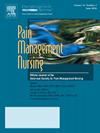The Impact of Depression, Social Support, and Sleep Quality on Opioid Misuse in Ambulatory Cancer Patients
IF 1.6
4区 医学
Q2 NURSING
引用次数: 0
Abstract
Problem: Prescription opioid analgesics are a cornerstone of cancer-related-pain management. However, recent legislative efforts aimed at reducing opioid prescribing have largely ignored the unique needs of this population. Pervasive fears of opioid misuse have created significant barriers to accessing essential pain relief. In order to safely prescribe and administer opioids in these populations, it is crucial to study predictors of opioid misuse and the development of OUD.
Purpose: This study aims to explore predictors of opioid misuse and the development of OUD in cancer patients to facilitate safe prescription of opioids.
Methods: This study concerns the analysis of preliminary data from an ongoing parent study (1R01NR017853) looking at longitudinal outcomes of opioid therapy in patients with cancer and how patterns of opioid use over time relate to patient-reported outcomes and healthcare utilization. Adult patients with cancer receiving outpatient oncology care were recruited from three different sites affiliated with the University of Pennsylvania Health System. A multivariable logistic regression model was used to analyze the extent to which different factors predict opioid misuse risk
Results: Having moderate depression (OR = 2.39, p = 0.03), moderately severe depression (OR = 12.49, p < 0.001), and severe depression (OR = 18.48, p < 0.001) were all correlated with higher odds of potential current opioid misuse compared to none-minimal levels of depression. Participants with low social support had higher odds of potential current misuse compared to participants with high social support (OR = 2.00, p = 0.011), and poorer sleep quality (OR = 1.11, p = 0.011) was also associated with higher odds of potential current misuse.
Implications: Depression, social support, and sleep quality are correlated with opioid misuse risk in cancer patients. To mitigate the risk of opioid misuse in cancer patients, nurses should assess patients’ mental health, social support, and sleep quality prior to starting opioid analgesics. Patients who exhibit signs of depression or inadequate social support or sleep should be provided with interdisciplinary support services along with their opioid therapy.
Future directions: Future research should explore the feasibility and efficacy of interdisciplinary care involving social support, mental health interventions, and sleep facilitation for cancer patients experiencing chronic pain.
求助全文
约1分钟内获得全文
求助全文
来源期刊

Pain Management Nursing
医学-护理
CiteScore
3.00
自引率
5.90%
发文量
187
审稿时长
>12 weeks
期刊介绍:
This peer-reviewed journal offers a unique focus on the realm of pain management as it applies to nursing. Original and review articles from experts in the field offer key insights in the areas of clinical practice, advocacy, education, administration, and research. Additional features include practice guidelines and pharmacology updates.
 求助内容:
求助内容: 应助结果提醒方式:
应助结果提醒方式:


